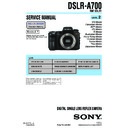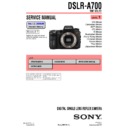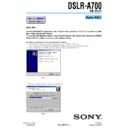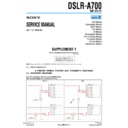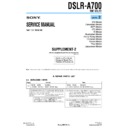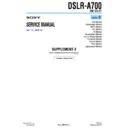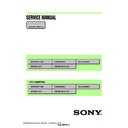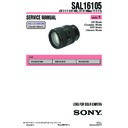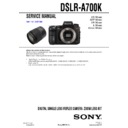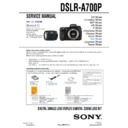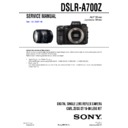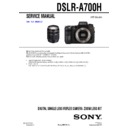Read Sony DSLR-A700 Service Manual online
Revision History
Revision History
Sony Corporation
DSLR-A700_L2
SERVICE MANUAL
LEVEL
2
Link
DISASSEMBLY
SERVICE NOTE
SPECIFICATIONS
SCHEMATIC DIAGRAMS
FRAME SCHEMATIC DIAGRAMS
BLOCK DIAGRAMS
REPAIR PARTS LIST
PRINTED WIRING BOARDS
Link
Ver. 1.6 2013.07
2013G08-1
© 2013.07
Published by Sony Techno Create Corporation
9-852-212-35
US Model
Canadian Model
AEP Model
UK Model
E Model
Australian Model
Hong Kong Model
Chinese Model
Korea Model
Thai Model
Japanese Model
The components identified by
mark 0 or dotted line with
mark 0 are critical for safety.
Replace only with part num-
ber specified.
mark 0 or dotted line with
mark 0 are critical for safety.
Replace only with part num-
ber specified.
Les composants identifiés par une
marque 0 sont critiques pour la
sécurité.
Ne les remplacer que par une pièce
portant le numéro spécifié.
marque 0 sont critiques pour la
sécurité.
Ne les remplacer que par une pièce
portant le numéro spécifié.
DIGITAL SINGLE LENS REFLEX CAMERA
DSLR-A700
RMT-DSLR1
Revised-3
Replace the previously issued
SERVICE MANUAL 9-852-212-34
with this manual.
SERVICE MANUAL 9-852-212-34
with this manual.
— 2 —
DSLR-A700_L2
SPECIFICATIONS
Camera
[System]
Camera Type
Digital Single Lens Reflex
Camera with built-in flash and
interchangeable lenses
Camera with built-in flash and
interchangeable lenses
Image format
23.5
×15.6mm (APS-C format)
Lens
All of Sony Lens
[Image sensor]
Total pixel number of camera
Approx. 13 053 000 pixels
Effective pixel number of camera
Approx. 12 246 000 pixels
[Super SteadyShot]
System
Image sensor-Shift mechanism
Super SteadyShot Compensation capability
Approximately 2.5 EV to 4 EV
decrease in shutter speed
(varies according to shooting
conditions and lens used)
decrease in shutter speed
(varies according to shooting
conditions and lens used)
[Anti-Dust]
System
Charge protection coating on
Low-Pass Filter and image
sensor-Shift mechanism
Low-Pass Filter and image
sensor-Shift mechanism
[Viewfinder]
Type
Fixed eye-level system with
optical glass type pentaprism
optical glass type pentaprism
Focusing Screen Spherical Acute Matte
Field of View
0.95
Magnification
0.9
× with 50mm lens at
infinity, –1 m
–1
Eye Relief
Approximately 25 mm from the
eyepiece, 21 mm from the
eyepiece frame at –1 diopter
(–1m
eyepiece, 21 mm from the
eyepiece frame at –1 diopter
(–1m
–1
)
Dioptor Adjustment
–3.0 to +1.0 m
–1
[Auto Focus System]
System
TTL phase-detection system,
CCD line sensors (Metering
area 11 points)
CCD line sensors (Metering
area 11 points)
Sensitivity Range
0 EV to +18 EV (at ISO 100
equivalent)
equivalent)
[Exposure]
Metering Cell
40-segment honeycomb-pattern
SPC
SPC
Metering Range 0 EV to 20 EV (+2 EV to +20
EV with Spot metering), (at
ISO 100 with F1.4 lens)
ISO 100 with F1.4 lens)
[Shutter]
Type
Electronically-controlled,
vertical-traverse, focal-plane
type
vertical-traverse, focal-plane
type
Speed range
1/8000 second to 30 seconds,
bulb
bulb
Flash Sync Speed
1/250 second (with Super
SteadyShot off),
1/200 second (with Super
SteadyShot on)
SteadyShot off),
1/200 second (with Super
SteadyShot on)
[Built-In-Flash]
Flash G.No.
GN 12 (in meters at ISO 100)
Recycling Time Approx. 3 seconds
[Recording media]
CompactFlash card(TypeI,II),
Microdrive, “Memory Stick
Duo”
Microdrive, “Memory Stick
Duo”
[LCD monitor]
LCD panel
7.5 cm (3.0 type) TFT drive
Total number of dots
921 600 (640
×3 (RGB) × 480)
dots
[Input/output terminals]
VIDEO OUT terminal
Special multi-connector
USB terminal
Special multi-connector, Hi-
speed USB (USB 2.0
compliant)
speed USB (USB 2.0
compliant)
HDMI OUT terminal
HDMI type C minijack
Sync. terminal
REMOTE terminal
[Power, general]
Used battery pack
Rechargeable battery pack
NP-FM500H
NP-FM500H
[Others]
PictBridge
Compatible
Exif Print
Compatible
PRINT Image Matching III
Compatible
Exif
Exif Ver.2.21
RAW
ARW2.0 format
Dimensions
Approx. 141.7
× 104.8 ×
79.7mm (55/8
× 4 1 /4 ×
3 1/4 inches) (W/H/D,
excluding protrusions)
excluding protrusions)
Mass
Approx.690 g (1 lb 8.3 oz)
(without batteries, memory card
and body accessories)
(without batteries, memory card
and body accessories)
Operating temperature
0 to 40
°C (32 to 104°F)
(When using the Microdrive: 5
to 40
to 40
°C (41 to 104°F))
BC-VM10 Battery charger
Input rating
100 V – 240 V AC, 50/60 Hz
Output rating
8.4 V DC, 750 mA
Operating temperature range
0 to 40
°C (32 to 104°F)
Storage temperature range
–20 to +60
°C (–4 to +140°F)
Maximum dimensions
Approx. 70
× 25 × 95 mm
(2 7/8
× 1 × 3 3/4 inches) (W/H/
D)
Mass
Approx. 90 g (3.2 oz)
Rechargeable battery pack NP-FM500H
Used battery
Lithium-ion battery
Maximum voltage
DC 8.4 V
Nominal voltage DC 7.2 V
Maximum charge current
2.0 A
Maximum charge voltage
DC 8.4 V
Capacity
11.8 Wh (1 650 mAh)
Maximum dimensions
Approx. 38.2
× 20.5 × 55.6 mm
(1 9/16
× 13/16 × 2 1/4 inches)
(W/H/D)
Mass
Approx. 78 g (2.8 oz)
Design and specifications are subject to change
without notice.
without notice.
1-1
ENGLISH
JAPANESE
ENGLISH
JAPANESE
DSLR-A700_L2
1. SERVICE NOTE
1-1. CHEMICALS
Some chemicals used for servicing are highly volatile.
Their evaporation caused by improper management affects your health and environment, and wastes resources.
Manage the chemicals carefully as follows.
Their evaporation caused by improper management affects your health and environment, and wastes resources.
Manage the chemicals carefully as follows.
•
Store chemicals sealed in a specific place to prevent from exposure to high temperature or direct sunlight.
•
Avoid dividing chemicals into excessive numbers of small containers to reduce natural evaporation.
•
Keep containers sealed to avoid natural evaporation when chemicals are not in use.
•
Avoid using chemicals as much as possible. When using chemicals, divide only required amount to a small plate from the container and
use up it.
use up it.
1-2. EXTERIOR PARTS
Be careful to the following points for plastic parts used in this unit.
•
Use a piece of cleaning paper or cleaning cloth for cleaning plastic parts. Avoid using chemicals.
Even if you have to use chemicals to clean heavy dirt, don’t use paint thinner, ketone, nor alcohol.
Even if you have to use chemicals to clean heavy dirt, don’t use paint thinner, ketone, nor alcohol.
•
Insert the specific screws vertically to the part when installing a plastic part.
Be careful not to tighten screws too much.
Be careful not to tighten screws too much.
1-3. UNLEADED SOLDER
This unit uses unleaded solder.
Boards requiring use of unleaded solder are printed with the lead free mark (LF) indicating the solder contains no lead.
(Caution: Some printed circuit boards may not come printed with the lead free mark due to their particular size.)
Boards requiring use of unleaded solder are printed with the lead free mark (LF) indicating the solder contains no lead.
(Caution: Some printed circuit boards may not come printed with the lead free mark due to their particular size.)
: LEAD FREE MARK
Be careful to the following points to solder or unsolder.
•
Set the soldering iron tip temperature to 350
°C approximately.
If cannot control temperature, solder/unsolder at high temperature for a short time.
Caution: The printed pattern (copper foil) may peel away if the heated tip is applied for too long, so be careful!
Caution: The printed pattern (copper foil) may peel away if the heated tip is applied for too long, so be careful!
Unleaded solder is more viscous (sticky, less prone to flow) than ordinary solder so use caution not to let solder bridges occur
such as on IC pins, etc.
such as on IC pins, etc.
•
Be sure to control soldering iron tips used for unleaded solder and those for leaded solder so they are managed separately. Mixing
unleaded solder and leaded solder will cause detachment phenomenon.
unleaded solder and leaded solder will cause detachment phenomenon.
1-4. SAFETY CHECK-OUT
After correcting the original service problem, perform the following safety checks before releasing the set to the customer.
1.
Check the area of your repair for unsoldered or poorly-soldered connections. Check the entire board surface for solder splashes and
bridges.
bridges.
2.
Check the interboard wiring to ensure that no wires are “pinched” or contact high-wattage resistors.
3.
Look for unauthorized replacement parts, particularly transistors, that were installed during a previous repair. Point them out to the
customer and recommend their replacement.
customer and recommend their replacement.
4.
Look for parts which, through functioning, show obvious signs of deterioration. Point them out to the customer and recommend their
replacement.
replacement.
5.
Check the B+ voltage to see it is at the values specified.
6.
Flexible Circuit Board Repairing
•
•
Keep the temperature of the soldering iron around 270
°C during repairing.
•
Do not touch the soldering iron on the same conductor of the circuit board (within 3 times).
•
Be careful not to apply force on the conductor when soldering or unsoldering.
SAFETY-RELATED COMPONENT WARNING!!
COMPONENTS IDENTIFIED BY MARK 0 OR DOTTED LINE WITH
MARK 0 ON THE SCHEMATIC DIAGRAMS AND IN THE PARTS
LIST ARE CRITICAL TO SAFE OPERATION. REPLACE THESE
COMPONENTS WITH SONY PARTS WHOSE PART NUMBERS
APPEAR AS SHOWN IN THIS MANUAL OR IN SUPPLEMENTS
PUBLISHED BY SONY.
MARK 0 ON THE SCHEMATIC DIAGRAMS AND IN THE PARTS
LIST ARE CRITICAL TO SAFE OPERATION. REPLACE THESE
COMPONENTS WITH SONY PARTS WHOSE PART NUMBERS
APPEAR AS SHOWN IN THIS MANUAL OR IN SUPPLEMENTS
PUBLISHED BY SONY.
ATTENTION AU COMPOSANT AYANT RAPPORT
À LA SÉCURITÉ!
LES COMPOSANTS IDENTIFÉS PAR UNE MARQUE 0 SUR LES
DIAGRAMMES SCHÉMATIQUES ET LA LISTE DES PIÈCES SONT
CRITIQUES POUR LA SÉCURITÉ DE FONCTIONNEMENT. NE
REMPLACER CES COMPOSANTS QUE PAR DES PIÈSES SONY
DONT LES NUMÉROS SONT DONNÉS DANS CE MANUEL OU
DANS LES SUPPÉMENTS PUBLIÉS PAR SONY.
DIAGRAMMES SCHÉMATIQUES ET LA LISTE DES PIÈCES SONT
CRITIQUES POUR LA SÉCURITÉ DE FONCTIONNEMENT. NE
REMPLACER CES COMPOSANTS QUE PAR DES PIÈSES SONY
DONT LES NUMÉROS SONT DONNÉS DANS CE MANUEL OU
DANS LES SUPPÉMENTS PUBLIÉS PAR SONY.
CAUTION
Danger of explosion if battery is incorrectly replaced.
Replace only with the same or equivalent type.
Replace only with the same or equivalent type.
1-2
ENGLISH
JAPANESE
ENGLISH
JAPANESE
DSLR-A700_L2
1-5. METHOD OF EXCHANGING SI SCREEN AND FOCUSING SCREEN
2
Remove focus plate retainer (SP).
1
Remove two claws pushing part A below,
and remove focus plate retainer (SP) in the
direction of arrow.
and remove focus plate retainer (SP) in the
direction of arrow.
4
Remove SI screen.
3
Remove focusing screen and VB washer.
Focusing Screen
SI Screen
Note: When you exchange the SI screen,
don't put dust or give a scratch.
VB Washer
Focus Plate Retainer (SP)
Focus Plate Retainer (SP)
Claw
Claw
Claw
A
Ver. 1.1 2007.10
The changed portions from
Ver. 1.0 are shown in blue.
Ver. 1.0 are shown in blue.
The focusing screen of the DSLR-A700 is available with two types,
standard and M type.
If the type was changed due to the replacement of focusing screen,
the setting must be changed according to the type.
Adjusting Item: “Focusing Screen Type Select”
standard and M type.
If the type was changed due to the replacement of focusing screen,
the setting must be changed according to the type.
Adjusting Item: “Focusing Screen Type Select”

